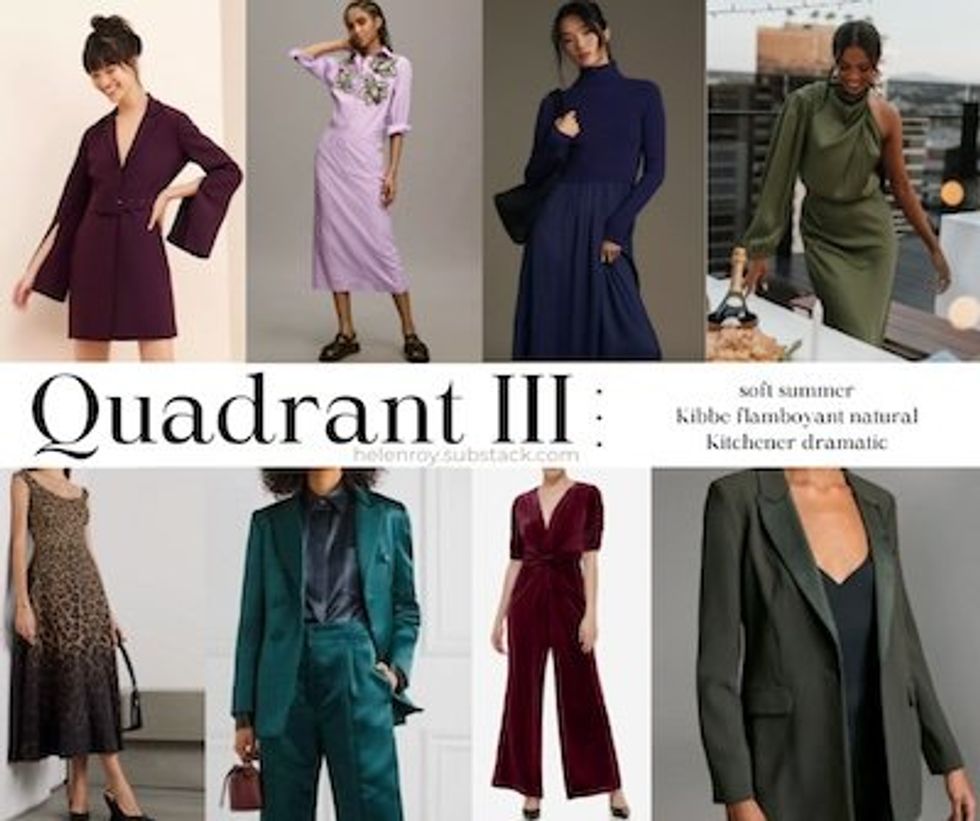You all seemed to like my post about time-blocking, which was very encouraging for the way it seemed to confirm my hypothesis that a demand for more practical guides still exists!
So I’m starting a series for the new or recent mom, the one I wish I could have read when I went from zero to one child, and then again and again, to help share what I’ve learned the hard way — so you don’t have to! This first edition is about dressing the maternal body, in all its implicit variation.
One of the initial humiliations of motherhood is that during and after having a baby, your old clothes may fit extremely poorly or look bad.
For me, it wasn’t just that they didn’t fall right on my body; my whole life, all my needs and purposes, had shifted. I no longer had an hour to figure out what looked best every time I needed to go somewhere. I needed to be able to move freely, but I also didn’t like to feel like a slob wearing sweats everywhere. I noticed how much it helped my productivity to get dressed, but I was frustrated and intimidated by the prospect of getting dressed, for fear of failing, looking like a clown, and wasting precious time.
If you currently find yourself in the position of having to dress a body that no longer feels like your own, this guide is for you.
I’m not sufficiently saintly to ever actually enjoy the pain of going through the hard parts of motherhood, but the grace of hindsight usually reveals that these little moments of death-to-self bring forth some previously unrealized nugget of truth. My hellish postpartum experience, for instance, prompted the discovery of everything I’m about to share. If you’re feeling discouraged about this right now, please know that there is a way through. Let me be your Beatrice!
Sartorial self-knowledge best begins, whether you’re a mom or not, with a couple basic typologies:
2) Kibbe body type analysis, and
3) Kitchener essence analysis.
For a clear explanation of each system, I’ve linked my favorite resources. The rest of this guide will make more sense the more familiar you are with each.
The beauty of these systems is that they help us to view bodies, shapes, patterns, and textures objectively with the ultimate purpose of helping to develop a subjective sense of style. All students must learn the basic principles of art and design before they can become artists themselves.
Each system, in its objectivity, is truly “body neutral” — for example, Kibbe is not “pro-fat” in the lewd way that pop culture insists on undressing bigger women in the name of feminist empowerment, nor is it “pro-thin” a la People magazine circa 2003.
Rather, the notion that every body has its unique features that can be enhanced and made more visually coherent by how we choose to dress is built into each system. No fitting square pegs into round holes here. For extra help, you can recruit a professional or crowdsource advice from Reddit.
It’s not uncommon for people trying to use one of these systems to give up early on when they realize that no one type fits them. They’re somewhere in between. That won’t happen here.
My system accounts for this in-betweeness, which I believe is magnified by the season of motherhood.
Seasonal color analysis
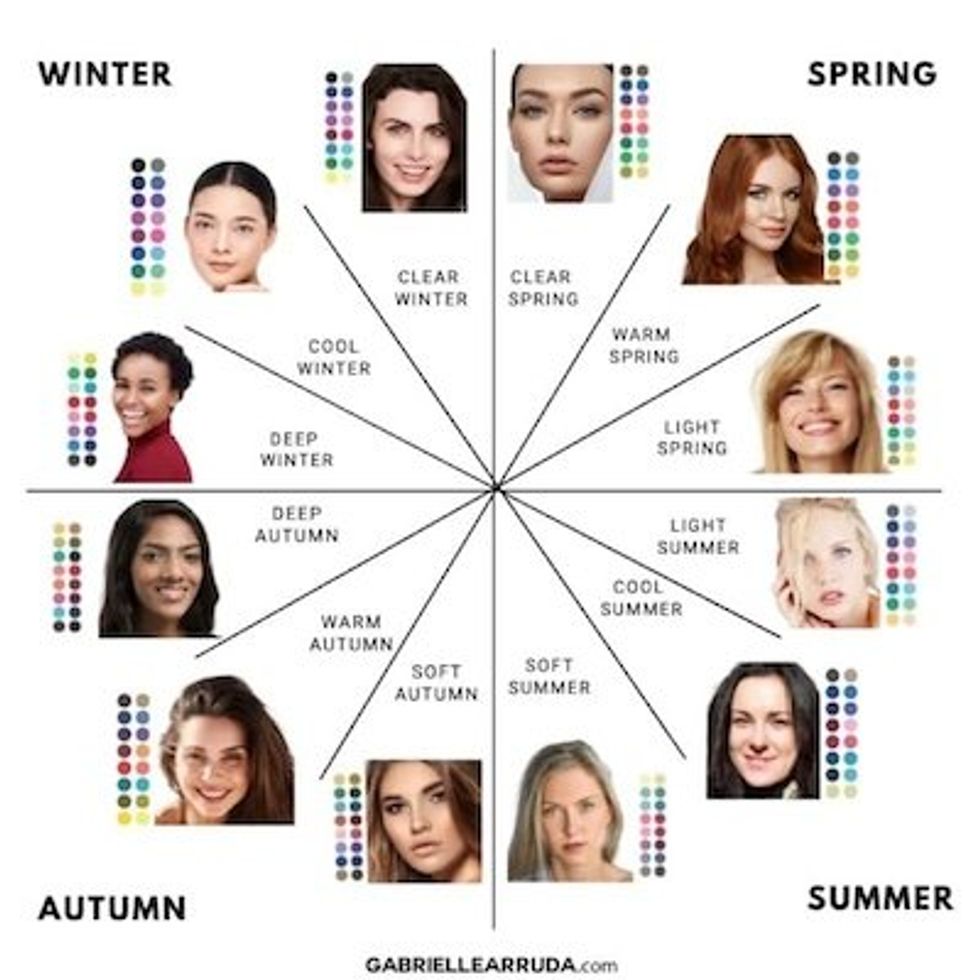
Personally, I’ve always found myself in between types, depending on a couple of factors. First, regarding seasonal color analysis, coloration may change with the actual passing of seasons. During the winter, I fall into a “soft summer” palette. During warmer months, with more orange tones in my skin and hair, I become a “soft autumn.” This is true for many, no matter the depth of your skin tone.
Kibbe body type analysis
Kibbe typology is complicated by the fact that a mother’s body will fluctuate in shape, often dramatically, in her childbearing years. The founder of Kibbe analysis, David Kibbe, says that one’s basic type does not change with weight gain. While I respect that, I do know that pregnancy can introduce changes to the female body that mere weight gain does not — changes in the structure of your pelvis, for instance. I
personally find that mommymaxxing can temporarily (or permanently) shift things in such a way that, if you were in between types to begin with, you might simply look better if you dressed in the direction of the more yin of the two.
To use myself as an example again, I find myself halfway between the body types “flamboyant natural” and “soft dramatic” on the Kibbe scale.
In my softer seasons, when pregnant or breastfeeding, I look my best dressing for the “soft dramatic” type, even though under more normal conditions, “flamboyant natural” suits best. Soft dramatic is technically on the
yang side of the two, but it is the most yin of the “dramatic” family, while “flamboyant natural” is the most yang of the “natural” family. So, of the two, soft dramatic ends up being a little more yin in the ways that matter. Still with me?
Kitchener essence analysis
The purpose of
Kitchener analysis is to describe the inherent quality that a person’s appearance gives off based on the natural line and shape of an individual’s face and body, her coloration, and her personality.
These factors combine to make Kitchener the most subjective method of all, the most subject to whimsy, and the most tailorable to the individual. Think of an extremely tall and lanky person (yang-dominant Kibbe “dramatic” type) but with a relatively small, round, soft face and an otherworldly kind of appearance. Anya Taylor-Joy comes to mind.
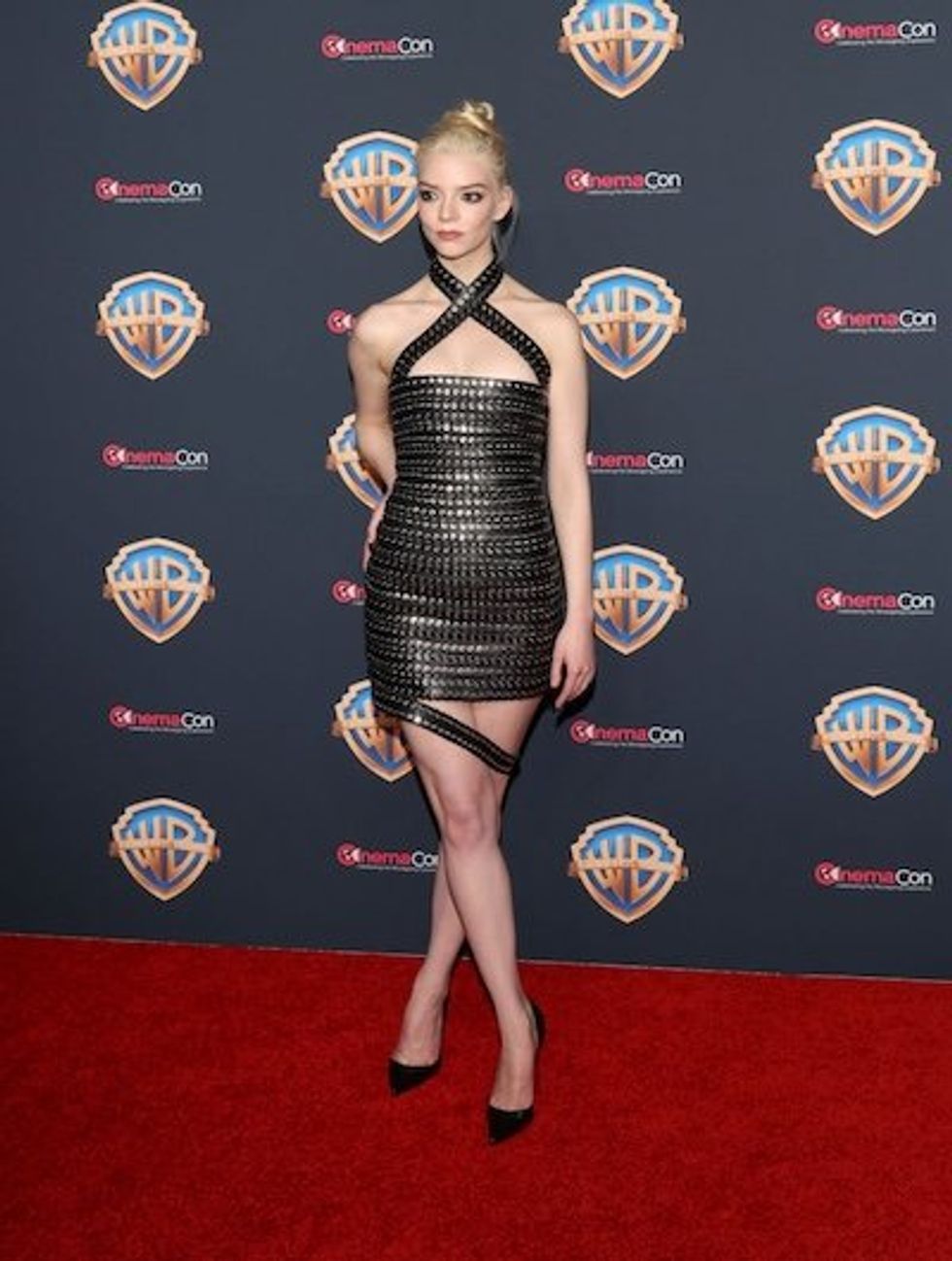
The Kitchener system accounts for these kinds of particularities; she might be a Kibbe “dramatic” type but with a Kitchener “ethereal” essence — bodily
yang, but essential yin. She therefore looks better in this kind of delicate and celestial fabric than other Kibbe “dramatics.” Most people, because most people are a confounding combination of yin and yang, cool and warm, and various personality traits, can see themselves in at least three of his archetypes, depending. Note: Though Kibbe and Kitchener use some of the same words, a Kibbe “gamine” is very much not the same as a Kitchener “gamine.”
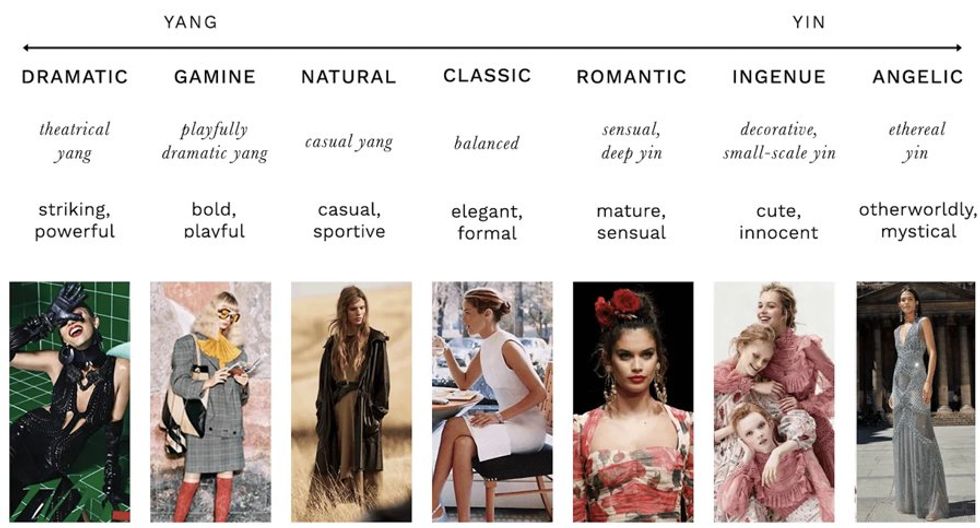
My system
The following method is how I synthesize, systematize, and, hopefully, simplify all the above information in order to accommodate the fluctuations of a
mother’s life.
As a mom I want to be able to
quickly figure out how to dress my best given any circumstance. Here’s how I do it:
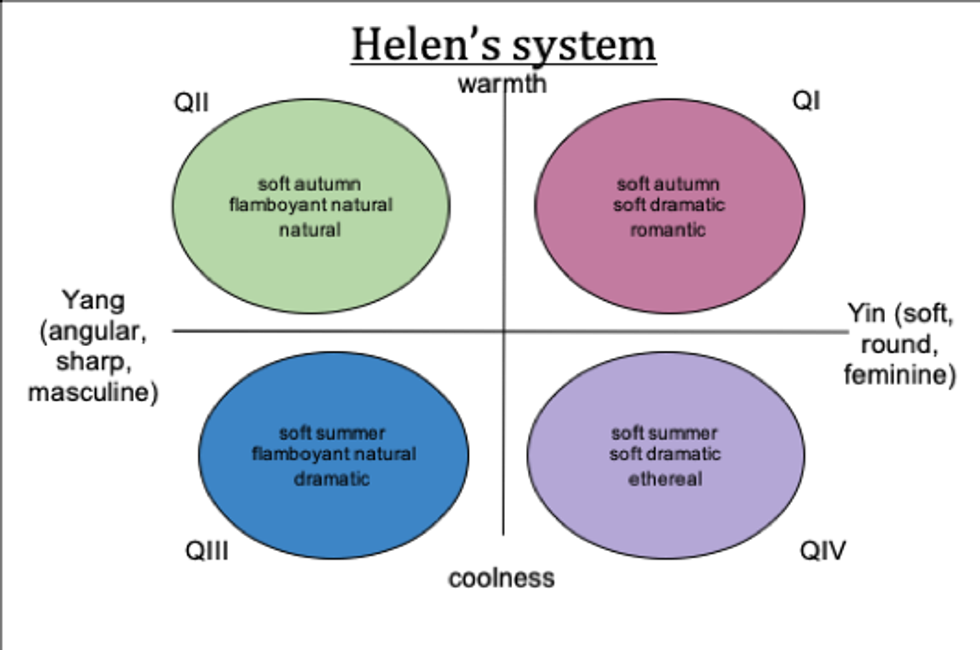
Step one: Take your deep dive into SCA and the Kibbe and Kitchener systems. Determine your primary and secondary types (under Kitchener, choose four essences).
Step two: Along intersecting x and y axes, plot by structure and coloration:
- x = Kibbe, structure, yin/yang
- y = SCA, temperature, cold/warm
One of your Kibbe types (the relatively more
yin type) will describe your more hormonally influenced maternal body, and the other will describe you under more normal conditions.
Step three: Place your types where they belong on the graph. For Kibbe and SCA, this will be relatively straightforward.
Your Kitchener types require a little creativity; this, especially, isn’t a straightforward quantitative determination, but a subjective one.
The basic concepts along the axes are informative. For example, when you consider the characteristics of a
romantic archetype, you probably imagine warmth and softness. It therefore belongs in my top right quadrant.
I placed my “natural” archetype in my warm,
yang QII because it makes me think of springtime: warmth and growth.
The remaining two of my Kitchener archetypes are subjectively “cooler,” and “dramatic” felt more masculine and
yang to me than ethereal.
What you’ll end up with is a quick, specialized reference that will help you make the best style selection according to real season, personal season, and personality.
I’ve drawn up some boards to illustrate the variety of items I’d wear depending on which quadrant I happen to find myself at any particular moment in time. Quadrants are numbered using the Roman numerals I, II, III, and IV, and they are labeled starting with the upper-right quadrant and moving counterclockwise.
In
Quadrant I, it is springtime or summertime, and I am either due soon or have just had a baby. The essence of this era is peak femininity and romance.
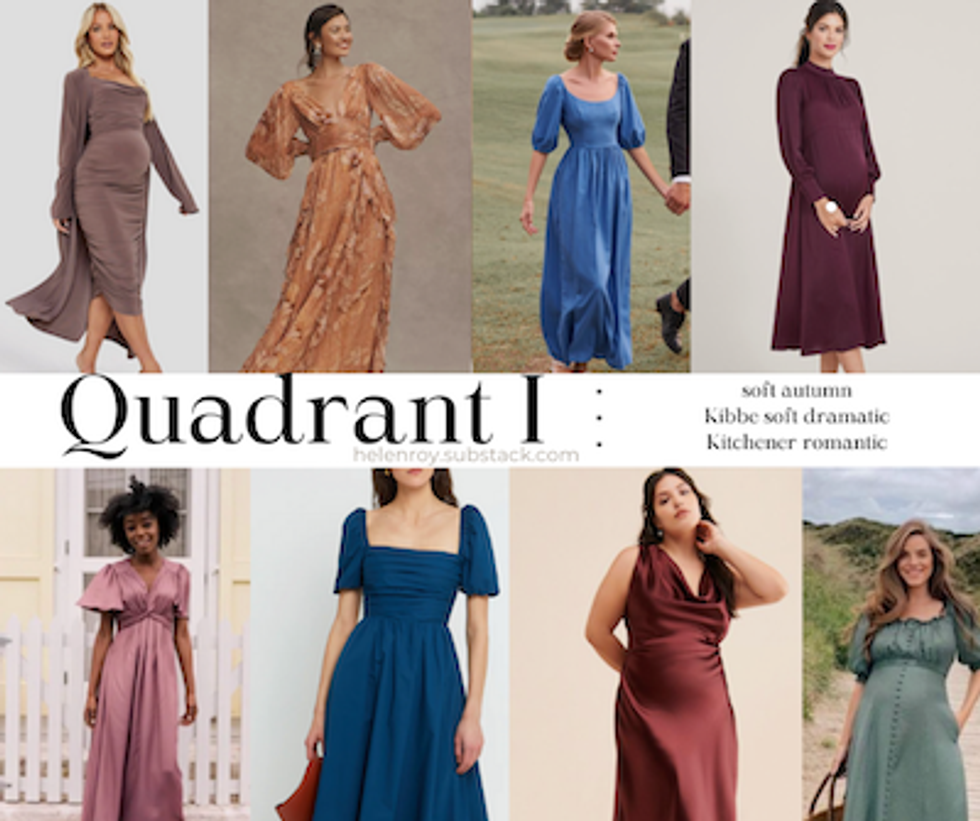
This means I am opting for silhouettes with a high A-line for subtle waist emphasis – enough to create shape and support my vertical line, but not to draw attention to my diastasis recti.
Necklines should have some drama and movement. Even the top right neckline, though it is a crewneck, has ruching around the neck, and the material adds some drama and interest.
In “soft dramatic” mode, it is best to avoid mix-and-match type outfits. I always, always prefer a “whole look,” best achieved through a dress.
We are going for sophistication and a deeply feminine sort of visual interest at the same time. I love to feel especially womanly during this phase of life, and dressing to emphasize removes the awkwardness of the postpartum phase as much as possible.
In
Quadrant II, it is warm outside, I am fully recovered from childbirth, and feeling athletic and strong in my body again.
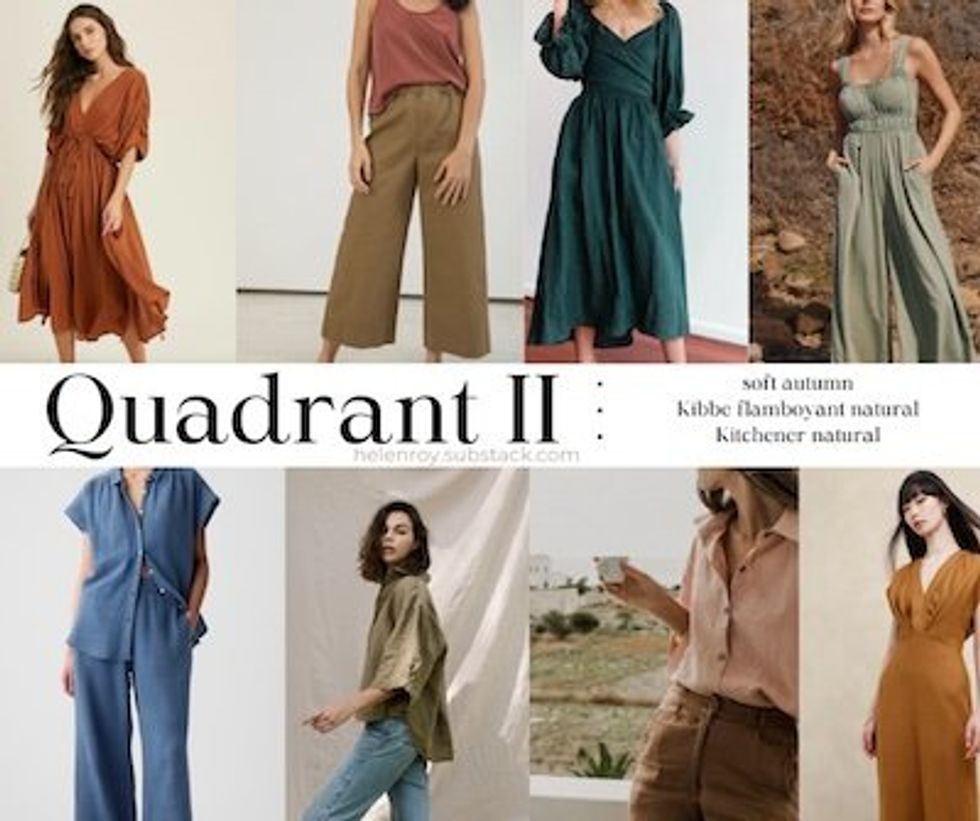
Now, I can reintroduce mix-and-match sets into my wardrobe. I love linens and earthy materials that, in the North Carolina heat, help me stay comfortable.
Loose lines with subtle waist emphasis (a
“french tuck” is good for this) suit my “flamboyant natural” frame now. The slightly more masculine kind of style pairs well with the angularity of my face once the baby fat melts away,
I LOVE a pantsuit. I go for soft but bold, sweeping lines. There is a relaxed element to my style here, but it isn’t baggy. Again, this is to accommodate the vertical line. This is not a time for shiny fabrics.
In
Quadrant III, it is cold outside, and I’m nowhere near childbirth.
Many of the similar principles from QII apply, since I’m still a flamboyant natural here (some relatively masculine silhouettes, always sweeping and extending length through the vertical line).
But I also like to introduce a bit of drama: animal prints, sequins, satin, and blazers with wide lapels and long hemlines. Colors have cooled down a bit, too; this is the perfect time for purple, burgundy, and navy.
Here in
Quadrant IV, I am either pregnant or postpartum, and it is the winter months.
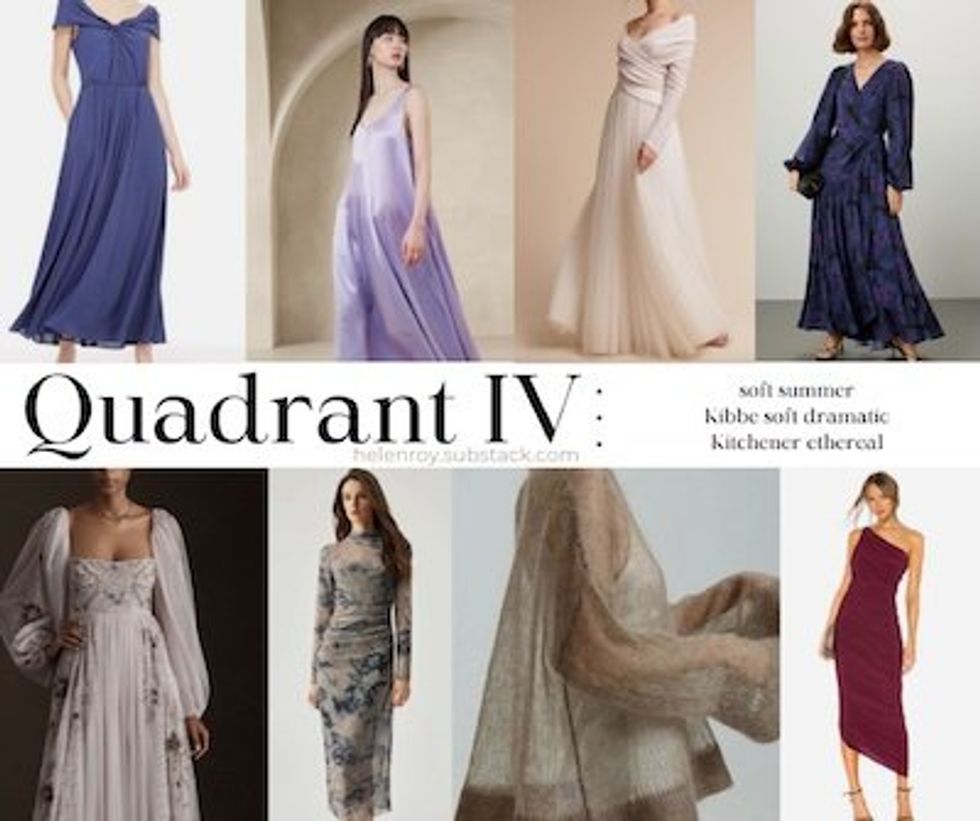
So again I am aiming for more softness and fluidity and exploring more ethereal motifs and textures. Sheerness is good for this, as well as a watercolor type of pattern. We are going for something slightly otherworldly — romantic but with an air of mystery, something beyond the veil.
Now that you’ve made it this far, I hope that you can see that the changing maternal body is never a cause for shame. There is so much you can do with the body God has given you
presently, even if it feels in between worlds, even if you don’t recognize it, and especially if you feel like it’s failing you.
Physical strength and beauty are goods worth refining, but I don’t believe in “getting your old body back” for its own sake, and I think our culture’s insistence on a mother looking like she’s never had children has to do with our much deeper unwillingness to define womanhood or offer a positive vision of womanhood beyond the stage during which we are maximally exploitable.
This is a relatively modern phenomenon. Writer Robert Graves popularized the notion that many ancient mythologies included a figure known as the Triple Goddess, an archetype embodying all three stages of a woman’s life: maiden, mother, matriarch.
As I’ve written elsewhere on this theme:
Seasons are meant to pass. When we attempt to preserve artificially what naturally expires, we destroy its potency and drive ourselves crazy in the process. This quest for endless leverage becomes the quiet tragedy of life for women under the current conditions: She finds herself in a state of constant misalignment. The degree to which she defies her feminine nature corresponds to her unhappiness.
I hope this guide helps any new or not-so-new mothers develop some confidence and flexibility in how they dress themselves and, in dressing themselves well, honor the unspeakably beautiful gift of maternity.

